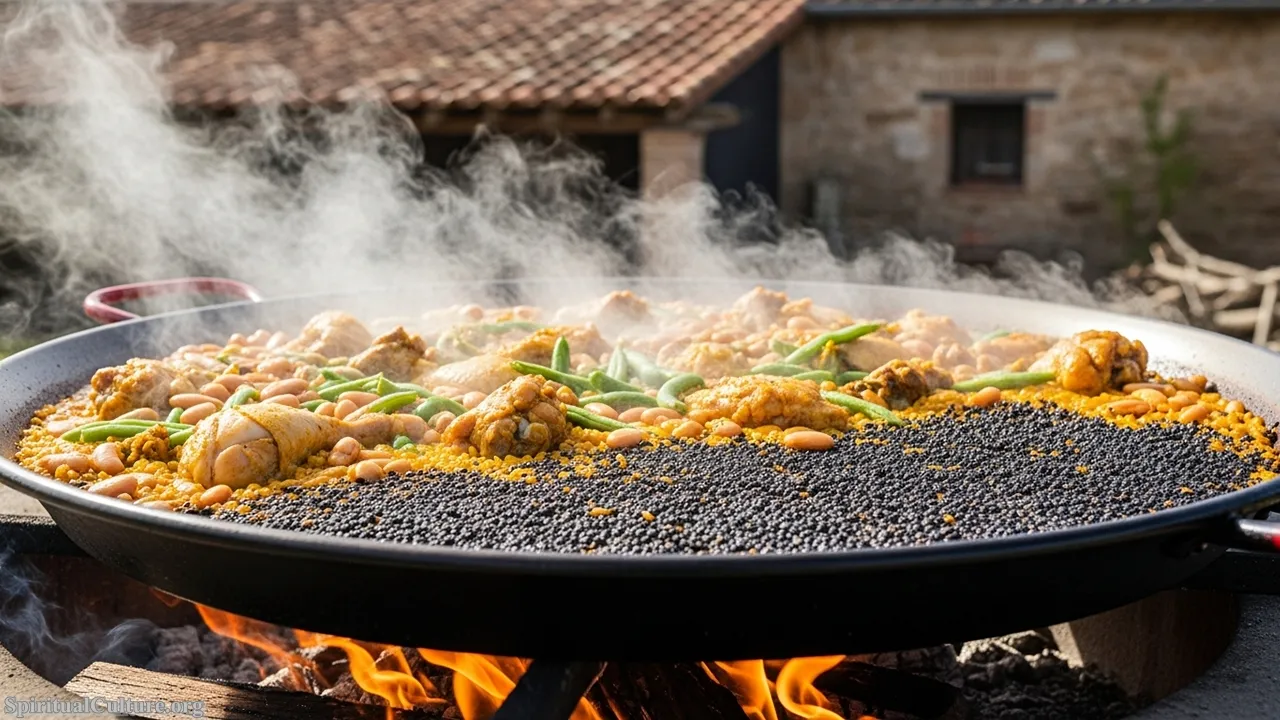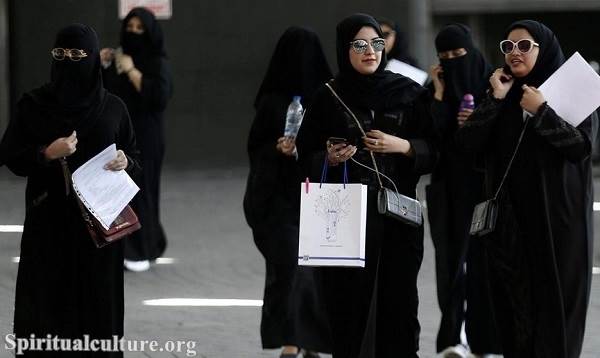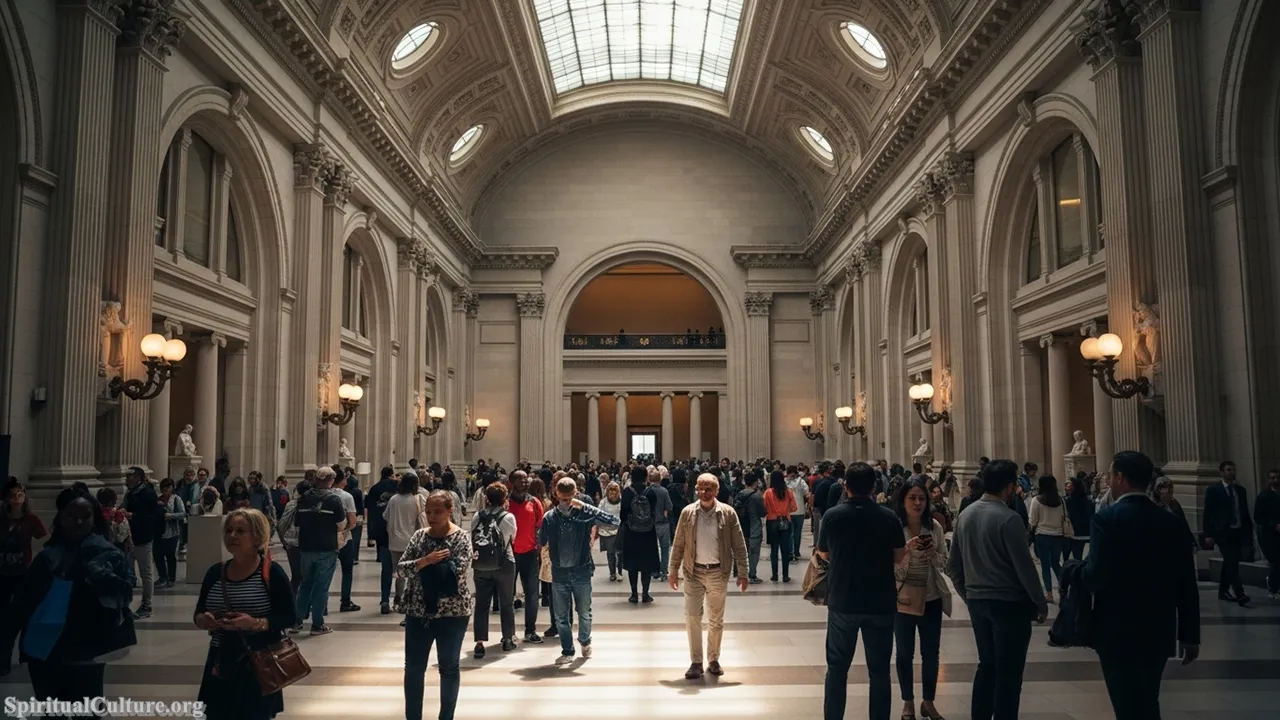The United Arab Emirates (UAE) stands today as a global nexus, but its modern veneer is firmly rooted in a rich tapestry of Arabian and Islamic heritage. As of the Current Time of Writing, the nation’s cultural identity is a celebration of the Bedouin values of hospitality, resilience, and connection to the desert and the sea. The government actively champions the preservation of its cultural heritage, successfully securing multiple elements on the UNESCO Intangible Cultural Heritage of Humanity lists. These traditions, ranging from ancient craft skills to communal social practices, are not mere relics of the past but living conduits that transmit the moral and spiritual values of the Emirati people to the next generation and to the more than 200 nationalities residing within its borders.
The enduring importance of these traditions is not measured by material wealth or global recognition alone, but by their spiritual influence—the ability to foster communal cohesion, reflect piety, and maintain an authentic sense of place and identity against the backdrop of rapid modernization. By analyzing factors such as UNESCO status, historical depth, and their continuing role in daily Emirati life and state-sponsored festivals, Spiritual Culture has compiled this authoritative ranking.
This list delves into the deeper meaning of the UAE’s most vital heritage practices, recognizing their foundational role in the nation’s cultural niche. From the quiet reverence of the Majlis to the dynamic spectacle of the Al-Ayyala dance, each tradition is a unique expression of the enduring soul of the Emirates.
Table of the Top 10 Most Important Cultural Traditions in the UAE
| Rank | Tradition | Primary Spiritual/Cultural Value | Historical Context/Period | UNESCO Status (Representative List) |
|---|---|---|---|---|
| 1 | Islam and Islamic Observances (Ramadan, Eid) | Piety, Communal Unity, Charity, Devotion | Since 630 AD (Arrival of Islam) | (Overarching framework, not an element) |
| 2 | Hospitality & The Majlis (Gahwa & Dates) | Generosity, Respect, Community Consultation | Ancient Bedouin/Islamic Tradition | Majlis (2015), Arabic Coffee (Gahwa) (2024) |
| 3 | Falconry (Al Qanasah) | Discipline, Connection to Nature, Desert Survival Ethos | Began in the Bronze Age (2500 BC) | Falconry, a living human heritage (2021) |
| 4 | The Date Palm (Nakhlah) | Sustenance, Resilience, Ecosystem Dependence | Neolithic Period (6000 BC) | Date palm, knowledge, skills, traditions and practices (2022) |
| 5 | Al-Ayyala (Traditional Stick Dance) | Unity, Collective Strength, Victory Celebration | Pre-Islamic to Early Modern Period | Al-Ayyala, a traditional performing art (2014) |
| 6 | Traditional Attire (Kandura & Abaya) | Modesty, Identity, Cultural Pride, Adherence to Sunnah | Deeply rooted in Islamic and local custom | (Integral to cultural life) |
| 7 | Nabati Poetry (Chanted Poetry) | Oral Tradition, Wisdom, Historical Record, Emotional Expression | Bedouin Oral Tradition (Centuries old) | Al-Taghrooda (2012), Al Azi (2017) |
| 8 | Al Sadu Weaving | Creativity, Sustainability, Female Skill, Bedouin Craftsmanship | Centuries old (Bedouin nomadic life) | Al Sadu, traditional weaving skills (2011) |
| 9 | Pearling and Sea Culture | Courage, Economic Resilience, Reliance on the Sea | Ancient maritime tradition (since 3rd millennium BCE) | (Heritage of coastal communities) |
| 10 | Arabic Calligraphy (Khatt) | Sacred Art, Spiritual Expression, Artistic Devotion | Post-630 AD (Islamic period) | Arabic calligraphy (2021) |
🔟 Top 10: Arabic Calligraphy (Khatt)
Arabic Calligraphy, or Khatt, is the art of writing the Arabic script in a decorative and visually expressive manner. As the script is the primary vehicle for the revelation of the Quran, this tradition transcends mere artistic expression to become an act of devotion and spiritual meditation. As of the Current Time of Writing, this tradition is experiencing a major contemporary resurgence in the UAE, with government-supported institutions and cultural hubs like the Dubai and Sharjah Calligraphy Centres promoting the craft’s spiritual and artistic value.
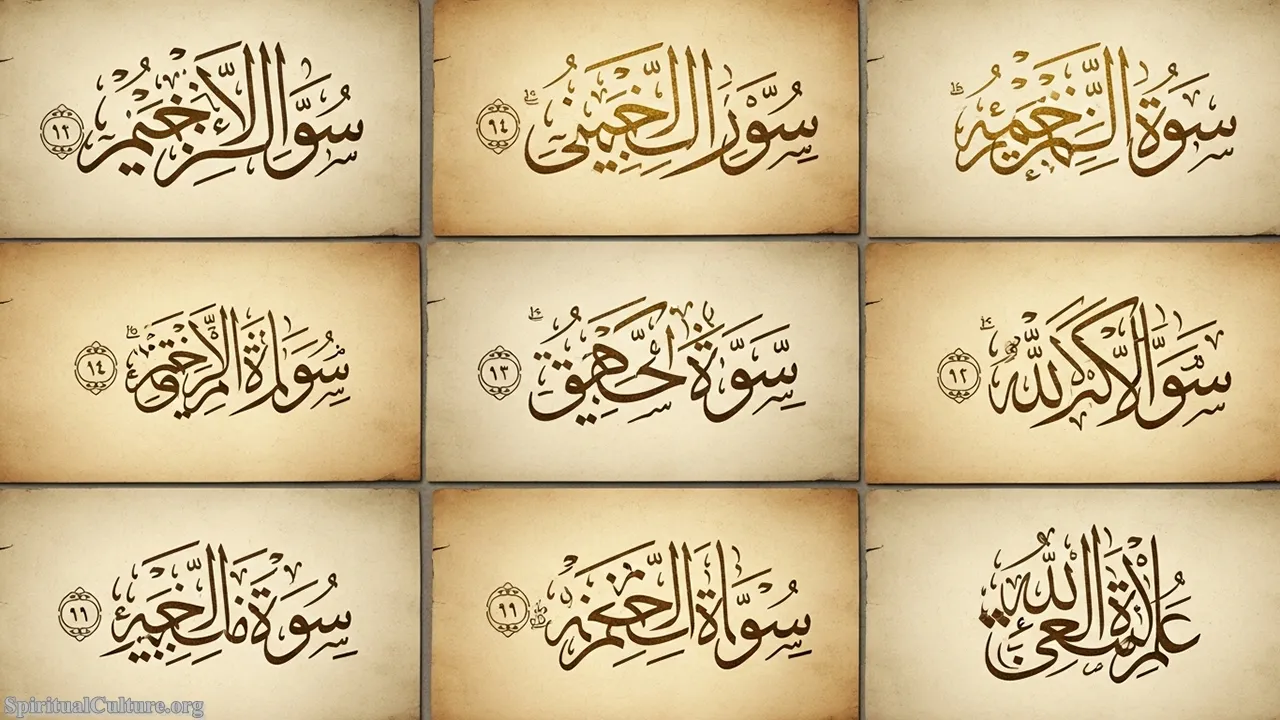
The core reason for its importance lies in its direct link to the sacred text of Islam. The meticulous discipline and geometric precision required to execute forms like Thuluth or Naskh is a spiritual exercise, requiring the practitioner to achieve a state of intense focus and harmony. This practice ensures the continuation of a heritage form that acts as a spiritual bridge, allowing the beauty of the written word to reflect the glory of the divine, as affirmed by its inscription on the UNESCO Representative List in 2021.
This tradition teaches a profound moral lesson: the pursuit of perfection through patience. The preservation of Khatt ensures that the aesthetic and spiritual heritage of the Islamic world remains vibrant, constantly reminding the modern, fast-paced Emirati society of the enduring power and beauty contained within the classical form.
Cultural/Spiritual Highlights
- Sacred Art: Used historically to transcribe the Quran, giving it a sanctified status.
- UNESCO Status (2021): Recognized for the “knowledge, skills and practices” involved.
- Meditation in Motion: The practice requires intense focus, serving as a form of spiritual discipline.
- Visual Identity: The art is central to the decoration of mosques, public buildings, and traditional homes.
9️⃣ Top 9: Pearling and Sea Culture
The traditions associated with pearling represent the foundational economic and social history of the coastal Emirates before the discovery of oil. Historically, pearling was a highly demanding and dangerous profession that instilled values of discipline, courage, reliance on God, and communal solidarity, all essential for survival at sea. As of the Current Time of Writing, though the industry itself is largely historical, its spirit is preserved in museums, heritage villages, and especially in the maritime folk music and songs that narrate the bravery of the divers and sailors.
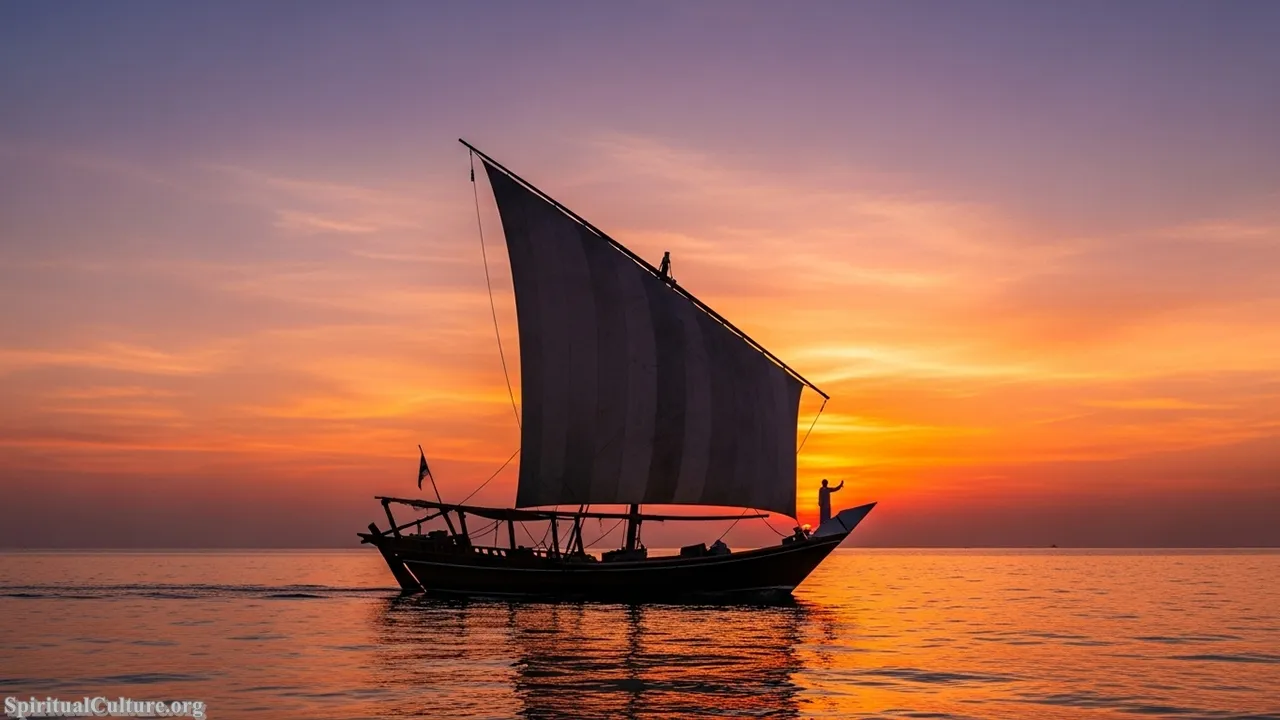
This tradition is ranked high because it established the original communal contract of the coastal communities, based on shared risk and reward, which mirrors the Islamic principle of mutual support (Takaful). The spiritual impact is reflected in the divers’ reliance on their faith to navigate the perilous conditions, viewing the sea as a blessing from the Creator. The songs, such as Nahham, acted as spiritual and rhythmic guides, maintaining morale and a connection to home.
The preservation of this sea culture honors the hardship and determination of the forefathers who built the foundation of the modern nation with only their skill and resilience. It serves as a powerful reminder that true wealth is built on character and cooperation, a moral lesson that resonates deeply even in the most prosperous of times.
Cultural/Spiritual Highlights
- Takaful: Represents the historical social security system based on shared risk among the crew.
- Noham (Sea Chants): Rhythmic songs that served as spiritual invocation and work-rate guides.
- Pre-Oil Economy: The foundation of the coastal Emirates’ trade and social structure for centuries.
- Courage and Resilience: Epitomizes the fortitude required to survive the elements.
8️⃣ Top 8: Al Sadu Weaving
Al Sadu is a traditional form of weaving practiced by Bedouin women, primarily using natural fibers from camels, goats, and sheep to create geometric patterns that reflect the desert environment and tribal identity. This ancient craft is more than a textile skill; it is a repository of cultural knowledge, where the patterns tell stories of the tribe, its history, and its values. It was inscribed on the UNESCO List in 2011 as a craft in urgent need of safeguarding, highlighting its critical cultural importance as of the Current Time of Writing.
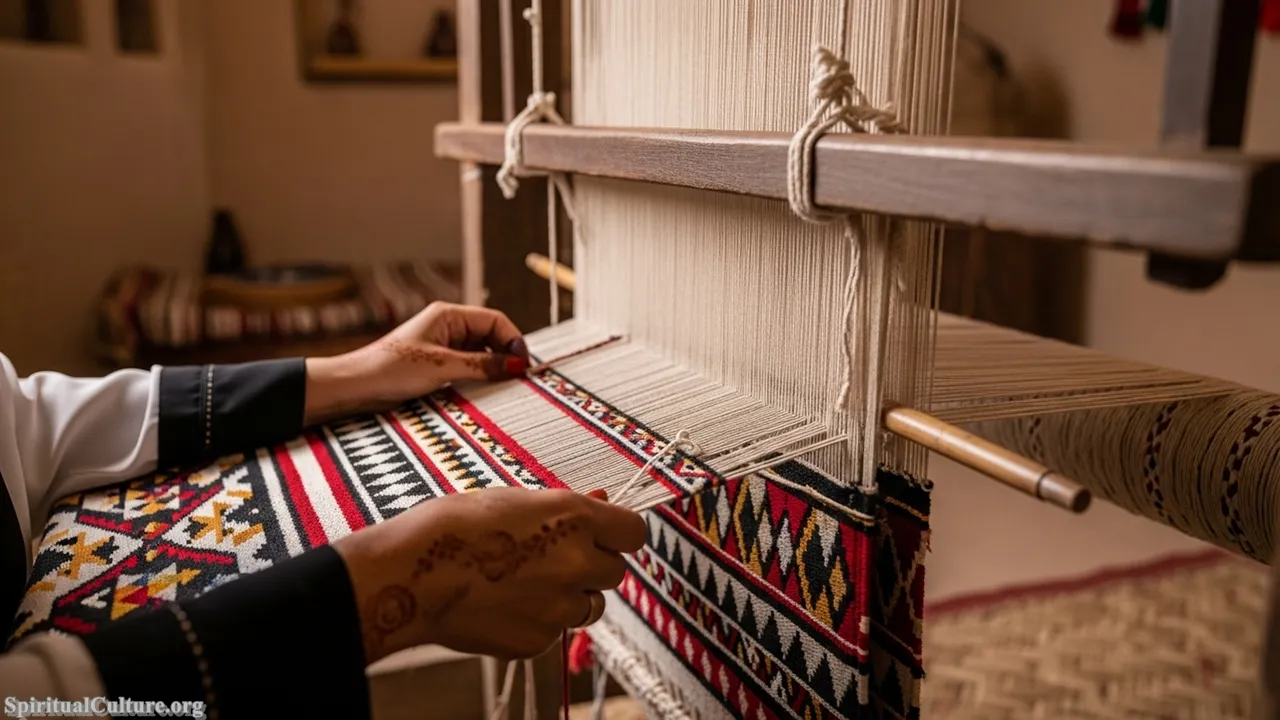
Its ranking is due to its profound representation of sustainability, resourcefulness, and the essential role of women in the nomadic society. The spiritual impact lies in the patience, devotion, and creativity imbued in each piece, which transforms raw natural material into objects vital for survival, such as tents (bayt al-sha’ar) and saddle bags. The rhythmic, repetitive nature of the weaving process can be a form of spiritual centering and reflection.
The preservation of Al Sadu celebrates the deep, resourceful wisdom of the Bedouin life, teaching the modern world a lesson in minimalism and ecological harmony. By supporting its continuity, the UAE secures a tangible link to its matriarchal and nomadic past, ensuring that this sustainable artistry does not fade away.
Cultural/Spiritual Highlights
- UNESCO Status (2011): Listed as in Need of Urgent Safeguarding.
- Female Heritage: Primarily practiced and passed down by Bedouin women, encoding tribal identity.
- Resourcefulness: Uses naturally available materials (camel/goat hair) to create essential items.
- Geometric Symbolism: Patterns carry spiritual or tribal meanings related to the desert and animals.
7️⃣ Top 7: Nabati Poetry (Chanted Poetry)
Nabati Poetry is the vernacular, spoken form of poetry deeply rooted in the Bedouin oral tradition of the Arabian Peninsula. It serves as a vital historical record, a vehicle for communal wisdom, and a profound outlet for emotional and spiritual expression, discussing themes of faith, love, tribal pride, and desert life. As of the Current Time of Writing, Nabati remains highly esteemed, with contemporary Emirati leaders, including Sheikh Mohammed bin Rashid Al Maktoum, being celebrated practitioners, giving it continued relevance in public discourse.
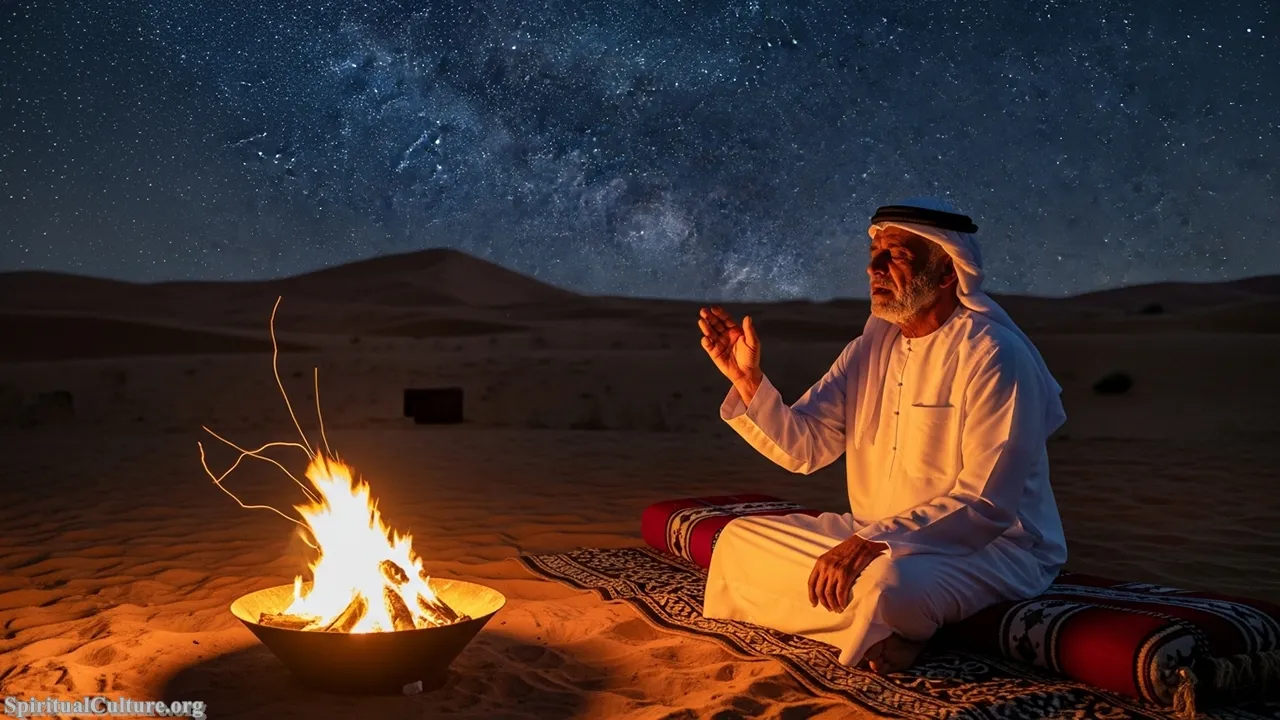
This tradition holds a high rank because it is the unwritten history and moral compass of the Emirati people. The spiritual impact is powerful: in a tradition like Al-Taghrooda (chanted poetry, UNESCO 2012), the rhythmic chanting was used to soothe the travel-weary and strengthen collective resolve on long journeys, effectively creating a shared, spiritual mantra. It is a powerful cultural tool that reinforces the community’s shared values and language.
Nabati’s preservation is critical, as it champions the value of the spoken word and oral history over mere written records. The moral lesson is the importance of eloquence and memory—that the deepest truths of a community can be carried on the breath of its people, preserving the soul of the Bedouin narrative for posterity.
Cultural/Spiritual Highlights
- Oral History: Served as the primary means of recording history, lineage, and desert wisdom.
- Emotional Channel: Addresses personal and spiritual themes otherwise kept private.
- UNESCO Status: Forms like Al-Taghrooda (2012) and Al Azi (2017) are inscribed.
- Elite Practice: Supported and practiced by the ruling families, ensuring contemporary relevance.
6️⃣ Top 6: Traditional Attire (Kandura & Abaya)
The Traditional Attire of the UAE—the white, ankle-length Kandura (or Dishdasha) for men, often paired with the Ghutra headscarf and Iqal cord, and the dark, flowing Abaya and Shayla (head covering) for women—is a constant, visible anchor of cultural and religious identity. This attire is a deliberate choice for modesty, climate comfort, and adherence to Islamic principles, and it is worn almost universally by Emiratis as of the Current Time of Writing, symbolizing unwavering cultural pride.

Its high ranking is attributed to its role as an uninterrupted visual expression of both Islamic faith and Emirati nationalism. The spiritual value is rooted in the concept of Haya (modesty) and Sunnah (the tradition of the Prophet), wherein clothing is a conscious, daily act of devotion. It clearly defines the cultural boundaries and identity of the local populace amidst a highly diverse and globalized environment.
The tradition teaches a profound moral lesson: that true value lies in substance, not superficiality. By maintaining this simple, elegant, and modest dress, Emiratis communicate a powerful commitment to their heritage and faith, promoting a culture that values character over fleeting trends.
Cultural/Spiritual Highlights
- Haya (Modesty): Primary Islamic principle guiding the design and use of the attire.
- National Identity: A universally recognized symbol of the UAE citizen’s cultural pride.
- Climate Adaptation: Designed to offer comfort and protection in the intense desert climate.
- Sunnah Adherence: Reflects the historical and religious ideal of simple, respectful dress.
5️⃣ Top 5: Al-Ayyala (Traditional Stick Dance)
Al-Ayyala, often referred to as the ‘Stick Dance’ or ‘Arab Dance’, is a highly formalized performance art practiced by men in two facing rows, simulating a battlefield line or a celebration of victory, accompanied by drums and chanted poetry. It is performed at every major national celebration, wedding, and official reception. Inscribed on the UNESCO Representative List in 2014, Al-Ayyala remains a dynamic and instantly recognizable marker of Gulf culture as of the Current Time of Writing.
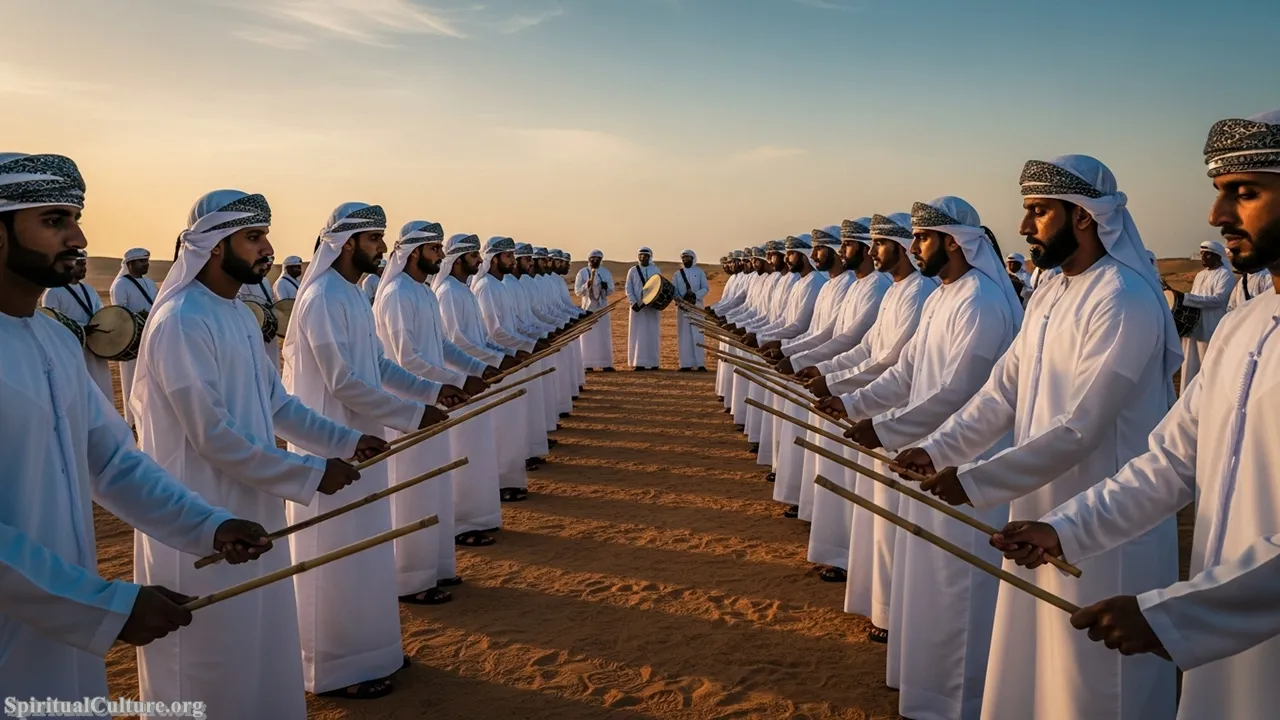
Al-Ayyala is ranked highly because it physically embodies the essential values of unity, collective strength, and preparedness in the face of adversity, values foundational to the successful creation of the UAE Federation in 1971. The spiritual impact is felt in the collective synchronicity of the performers, which generates a powerful, almost meditative energy of communal cohesion and national pride. It’s a spiritual assertion of the community’s steadfastness.
The preservation of this dance is a continuation of the tradition of Al-Harbiya (the war dance), which taught young men the discipline and solidarity necessary for tribal defense. It offers the moral lesson that true power lies in coordinated action and unified purpose, a principle crucial for the nation’s continued stability and growth.
Cultural/Spiritual Highlights
- UNESCO Status (2014): Inscribed as a traditional performing art.
- Symbol of Unity: The synchronized movement of the two rows represents the collective strength of the community.
- Celebration of Victory: Historically performed after successful defense or hunting, now for national events.
- Physical Discipline: Requires rhythm and precise movement, fostering respect for order and collective effort.
4️⃣ Top 4: The Date Palm (Nakhlah)
The Date Palm (Nakhlah) is arguably the single most important element of the UAE’s historical and cultural ecosystem. For millennia, it provided not just the staple food (tamr) but also wood for construction, fronds for shade and weaving (like Al Sadu), and relief from the brutal desert climate. The deep, life-giving connection between the Emirati people and the date palm was formally recognized by UNESCO in 2022. The preservation of oases, particularly the UNESCO World Heritage Site of Al Ain, highlights its continuing cultural and ecological importance as of the Current Time of Writing.
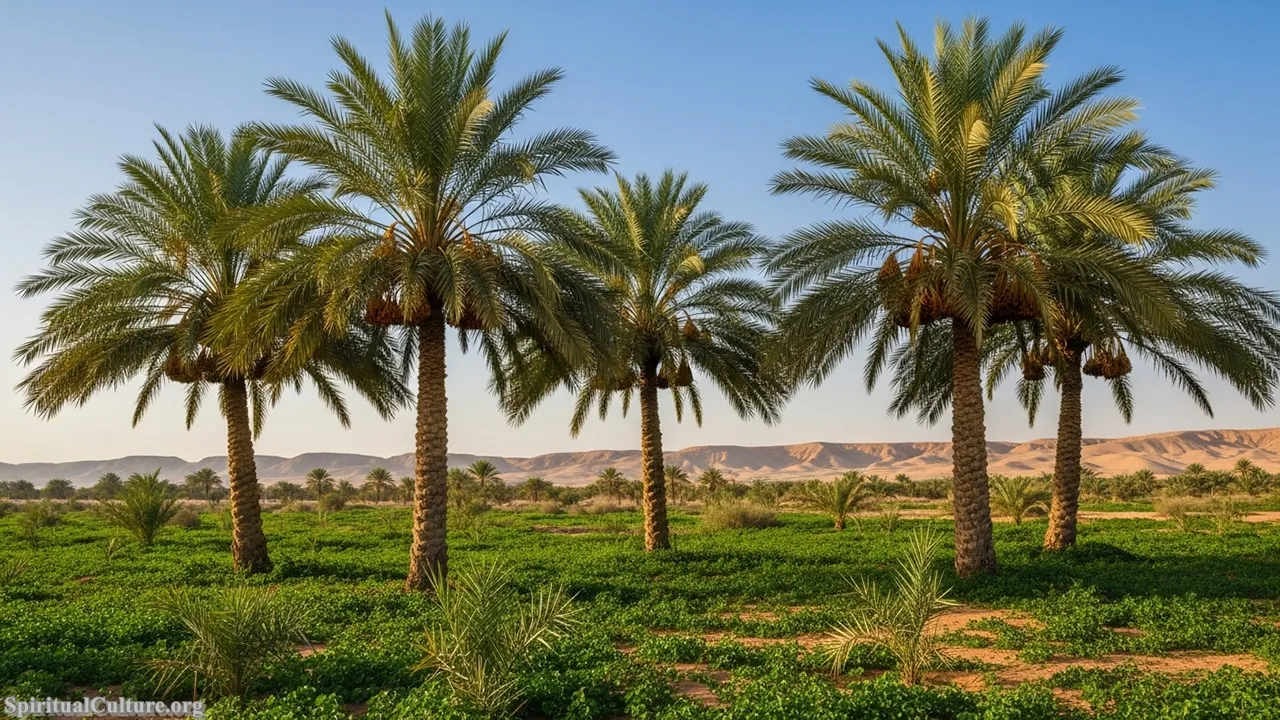
This tradition is critical because the date palm represents the resilience, life-giving nature, and enduring connection to the harsh desert landscape. The spiritual impact is woven into Islamic tradition itself, where the date is recommended at the breaking of the fast (Iftar) during Ramadan. It symbolizes abundance and blessing, transforming an arid land into a place of sustenance—a powerful spiritual metaphor for God’s provision.
The reverence for the date palm teaches a moral lesson in gratitude and deep respect for the environment. Its enduring presence reminds Emiratis of the fragile balance of the desert ecosystem and the wisdom of sustainable living practiced by their ancestors.
Cultural/Spiritual Highlights
- Divine Provision: A staple food (tamr) mentioned in the Quran, representing life and blessing.
- UNESCO Status (2022): Recognized for the “knowledge, skills, traditions and practices” associated with it.
- Foundation of Survival: Historically provided food, shelter, and material for tools and crafts.
- Symbol of Resilience: Thrives in the desert, embodying the enduring spirit of the Emirati people.
3️⃣ Top 3: Falconry (Al Qanasah)
Falconry, or Al Qanasah, is a profoundly ancient hunting tradition spanning millennia, originally a necessary survival skill for the Bedouin to acquire meat in the harsh desert. Today, it has evolved into a highly respected cultural and heritage sport that involves deep, almost familial bonds between the falconer and the bird. Recognized by UNESCO in 2021 as a living human heritage, it is one of the UAE’s most protected and prestigious traditions as of the Current Time of Writing.
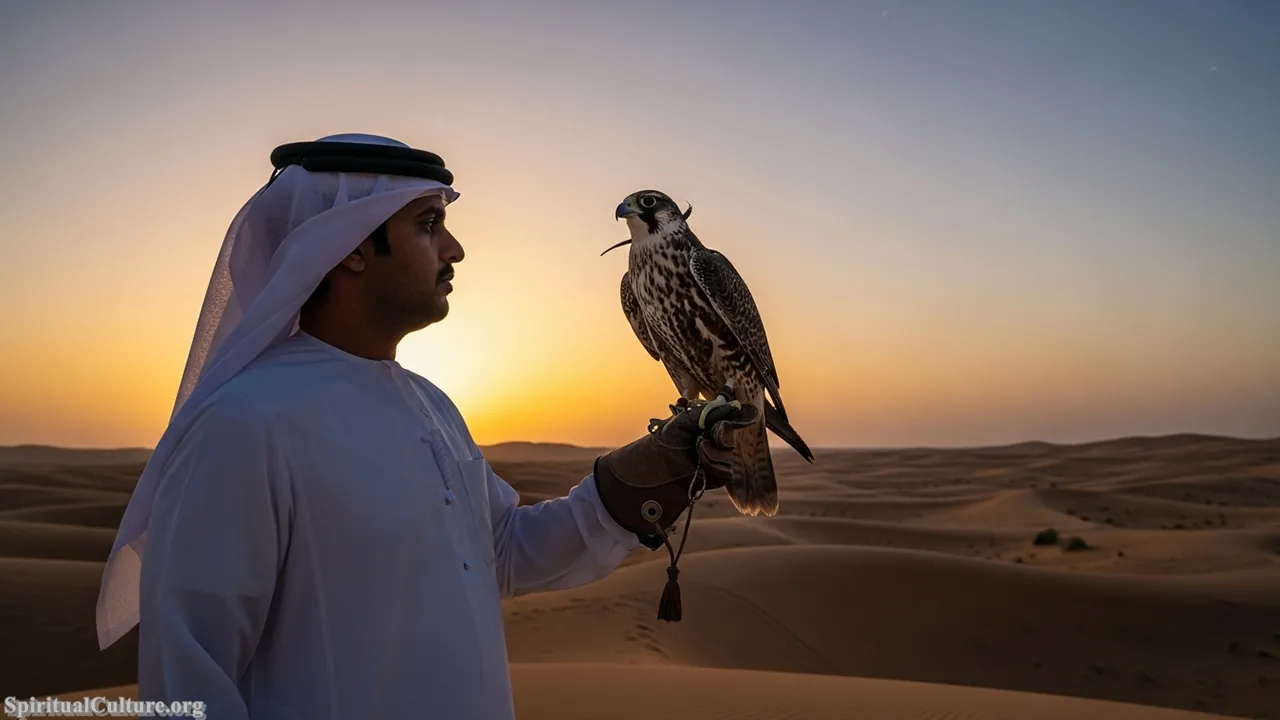
Its high ranking is secured by its symbolic representation of discipline, courage, and the mastery of the desert environment. The spiritual significance lies in the unique, intimate partnership between human and animal, where trust and respect are paramount. The falconer’s patience and meticulous training reflect a spiritual discipline—the ability to harness a powerful force of nature through gentle wisdom. This tradition embodies the self-reliance and honor of the Bedouin ethos.
The preservation of falconry teaches the moral lesson of respect for the wild and the virtue of patience. It ensures that the knowledge of the desert—its topography, its wildlife, and the intricate relationship between man and nature—is transmitted, fostering a sense of stewardship over the environment.
Cultural/Spiritual Highlights
- UNESCO Status (2021): Inscribed as a living human heritage, led by the UAE.
- Desert Ethos: Embodies Bedouin values of honor, self-sufficiency, and discipline.
- Man-Animal Bond: Reflects the deep, almost spiritual respect and partnership with the falcon.
- Conservation Tool: Modern falconry clubs actively promote global bird and prey conservation.
2️⃣ Top 2: Hospitality & The Majlis (Gahwa & Dates)
Hospitality, centered around the practice of the Majlis and the ritual serving of Arabic coffee (Gahwa) and dates, is the non-negotiable bedrock of Emirati social and cultural life. The Majlis is a traditional receiving space for social gatherings, consultation, and welcoming guests, embodying the value of open communication and respect. Gahwa and dates are the indispensable symbols of generosity, formalized by UNESCO recognition in 2015 and 2024 respectively. This custom remains constant across all seven Emirates as of the Current Time of Writing.
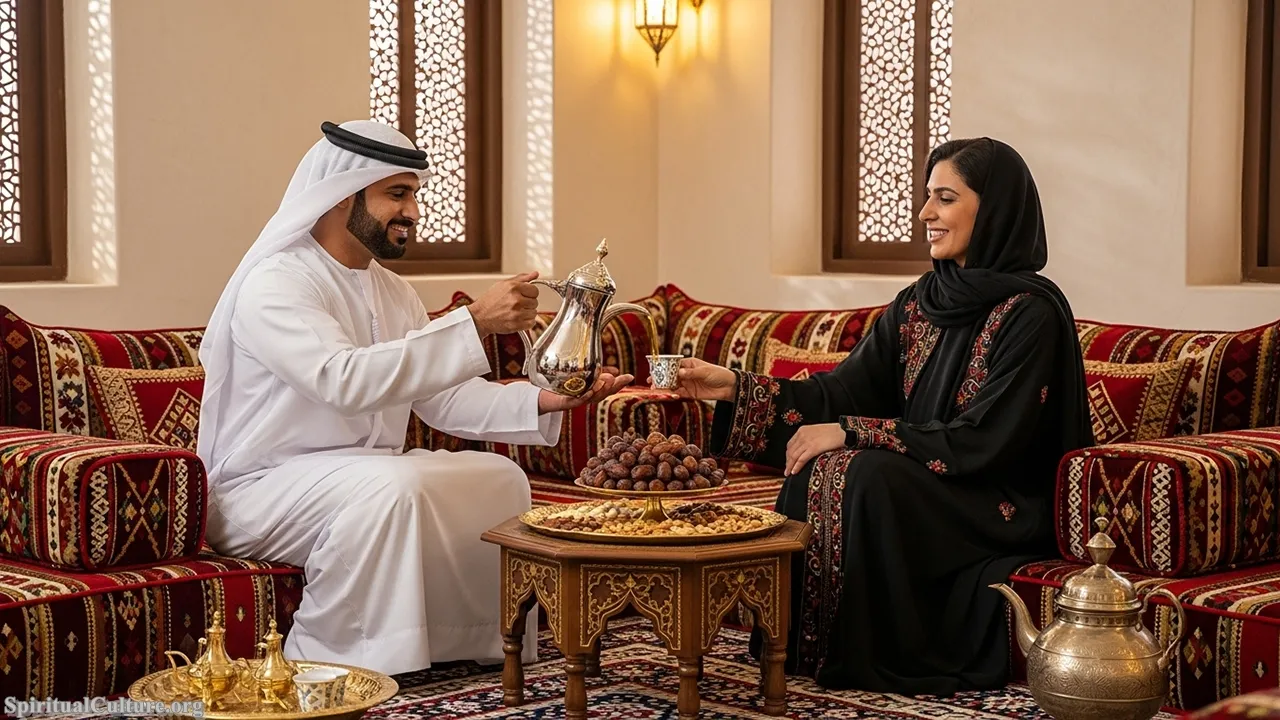
This tradition holds the second-highest rank because it is the primary cultural expression of Islamic virtue in the social sphere. The spiritual impact is immense, as the act of welcoming a guest and offering food and drink is considered a moral imperative and an act pleasing to God in Islam. It is a constant, practical application of the values of generosity, humility, and peaceful consultation, solidifying community bonds daily.
The preservation of the Majlis and its associated customs is a crucial lesson in humane communication and community cohesion. It offers a quiet, unhurried space for elders to pass wisdom to the youth and for leaders to listen to their people, ensuring the continuation of a society built on mutual respect and open-door generosity.
Cultural/Spiritual Highlights
- Majlis (UNESCO 2015): A cultural and social space for consultation and welcoming guests.
- Gahwa (UNESCO 2024): Arabic coffee is a universal symbol of generosity and honor for a guest.
- Sunnah Practice: Hospitality to guests is a highly recommended practice in Islam.
- Social Cohesion: Ensures dialogue and the democratic exchange of views within the community.
1️⃣ Top 1: Islam and Islamic Observances (Ramadan, Eid)
The foundation of the UAE’s identity, society, law, and culture is Islam. The observance of the Five Pillars, particularly Prayer (Salat) and the fast of Ramadan, are not merely religious acts but profound cultural practices that define the rhythm of the year and the moral behavior of the community. Every other tradition in this list is integrated within this overarching framework. As of the Current Time of Writing, the UAE champions itself as a global model for religious tolerance and coexistence, all while maintaining Islam as the core spiritual and legal reference.

Islam ranks first because it is the spiritual wellspring and governing code that gives meaning and direction to all other Emirati traditions. The observance of Ramadan, with its communal Iftar and intense charity, and the festivals of Eid al-Fitr and Eid al-Adha, are the highest expressions of shared piety, unity, and self-discipline. This cultural commitment to faith ensures that the nation’s progress is spiritually grounded and morally guided.
The moral and spiritual lesson is the recognition of a life lived under the guidance of Divine Law and Moral Accountability. The unwavering commitment to Islamic observances provides the nation with a deep, enduring sense of purpose, ensuring that its cultural heritage remains anchored in timeless, transcendental values of justice, compassion, and peace.
Cultural/Spiritual Highlights
- Foundational Pillar: The legal and ethical framework for the entire UAE society.
- Ramadan and Eid: The highest expressions of communal piety, fasting, and charity (Zakat).
- Call to Prayer (Adhan): A rhythmic, daily reminder that structures time and daily life.
- Global Coexistence: The faith is practiced with a simultaneous, state-promoted value of tolerance and respect for other faiths.
Conclusion
The Top 10 Most Important Cultural Traditions in the UAE are a collective testament to the enduring soul of the Arabian Peninsula. From the quiet discipline of the falconer to the rousing chorus of the Al-Ayyala, and from the humble hospitality of the Majlis to the profound spiritual rhythm of Ramadan, these practices are far more than historical footnotes. They are living, vibrant traditions that actively shape the nation’s moral fabric and spiritual identity as of the Current Time of Writing. In a world of accelerating change, the UAE’s commitment to preserving its UNESCO-inscribed heritage—a heritage rooted in Bedouin resilience and Islamic values—serves as a powerful, humanistic anchor. Spiritual Culture celebrates the UAE for demonstrating that true national progress is achieved when modernization is built not on the erasure of the past, but on the celebration and continuation of its most cherished spiritual and cultural legacies.
